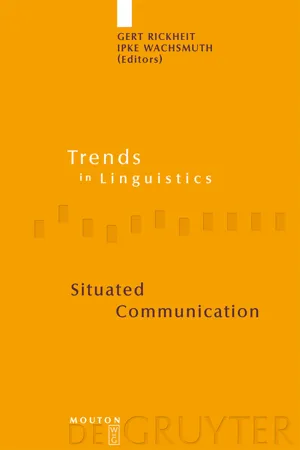
- 455 pages
- English
- PDF
- Available on iOS & Android
Situated Communication
About this book
This volume presents important results of the Collaborative Research Center (Sonderforschungsbereich) "Situated Artificial Communicators," which was funded by grants from the German Research Foundation (Deutsche Forschungsgemeinschaft) for more than twelve years.
The contributions focus on different aspects of human-human and human-machine interaction in situations which closely model everyday workplace demands. The authors are linguists, psycho- und neurolinguists, psychologists and computer scientists at Bielefeld University. They jointly tackle questions of information processing in task-oriented communication. The role of key notions such as context, integration (of multimodal information), reference, coherence, and robustness is explored in great depth.
Some remarkable findings and recurrent phenomena reveal that communication is, to a large extent, a matter of joint activity. The interdisciplinary approach integrates theory, description and experimentation with simulation and evaluation.
Frequently asked questions
- Essential is ideal for learners and professionals who enjoy exploring a wide range of subjects. Access the Essential Library with 800,000+ trusted titles and best-sellers across business, personal growth, and the humanities. Includes unlimited reading time and Standard Read Aloud voice.
- Complete: Perfect for advanced learners and researchers needing full, unrestricted access. Unlock 1.4M+ books across hundreds of subjects, including academic and specialized titles. The Complete Plan also includes advanced features like Premium Read Aloud and Research Assistant.
Please note we cannot support devices running on iOS 13 and Android 7 or earlier. Learn more about using the app.
Information
Table of contents
- Frontmatter
- Contents
- Introduction
- The constitution of meaning in situated communication
- Processing instructions
- Visually grounded language processing in object reference
- Psycholinguistic experiments on spatial relations using stereoscopic presentation
- Deictic object reference in task-oriented dialogue
- Computational models of visual tagging
- Neurobiological aspects of meaning constitution during language processing
- Neuroinformatic techniques in cognitive neuroscience of language
- Situated interaction with a virtual human - perception, action, and cognition
- Integrated perception for cooperative human-machine interaction
- Architectures of situated communicators: From perception to cognition to learning
- A systems framework of communicative understanding
- System theoretical modeling on situated communication
- Backmatter